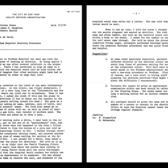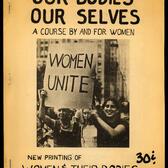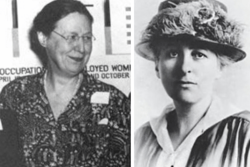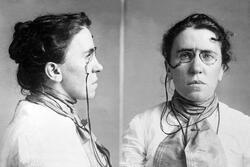The Translators and Spies of the Reproductive Rights Movement
This Women’s History Month, the Jewish Women’s Archive is celebrating the thousands of Jewish women who have participated in activism and resistance in the United States. We all know the names of the most famous women who shaped these movements, from Gloria Steinem to Emma Goldman: the women with the megaphones, with the loud voices and stirring speeches, the women whose names made it into the history books. But one person alone can never make a movement. This month, we’re celebrating the women behind the scenes: the academics, the researchers, the women who posted bail and drove getaway cars for their more famous friends. These behind-the-scenes resistors are not as well-known, but their stories and legacies are no less important than those of the frontline women we all love. Find out more about the project. We hope that by sharing these resistors’ stories and contributions, we will demonstrate that you don’t need the loudest voice or the most extroverted personality to effect change. And we hope to inspire you to bring your own skills to the causes most important to you in 2017.
In 1969, women still needed their husbands’ permission to get birth control. Doctors often withheld diagnoses of cancer, STDs, high-risk pregnancies, and other problems from female patients and either told their husbands or acted on the information themselves. If women were to make their own decisions about their bodies, they needed doctors they could trust to give them information and respect their choices. There were just two small problems: How could you know if a doctor was trustworthy if you didn’t know what questions to ask them or what an accurate answer should look like?
So, the Boston Women’s Health Book Collective decided to create a guide that would let women know how their bodies were supposed to work, what it looked and felt like when things went wrong, and what questions they should ask their doctors about possible treatment options. These women wrote detailed articles on anatomy, childbirth, abortion, and more, collecting them all in one volume: Our Bodies, Ourselves. First distributed by hand, then commercially published in 1973, the book quickly became the go-to guide for women who wanted to make their own decisions about their reproductive health.
The fight for reproductive rights has always been a battle on multiple fronts. The Boston Women’s Health Book Collective struck a major blow for women’s ability to make their own choices, and the Supreme Court’s 1973 Roe v Wade decision changed the game in terms of safe, legal access to abortion. While these iconic victories are hugely important, women continue to face obstacles that slip under the radar: a shortage of local clinics, cultural or economic barriers, and the stigma that makes it hard to even talk about abortion. And to fight those, sometimes we need unconventional heroes; we need people who come at the problems from unexpected angles.
Fania Mindell came to the fight early, in every sense of the word: she was only twenty-two when she first met Margaret Sanger (the future founder of Planned Parenthood) and her sister Ethyl Byrne in 1916. At first glance, Mindell might have seemed an unlikely champion of reproductive rights.
Unlike Sanger, Mindell didn’t give speeches or lead protests, and she had no medical training. But Mindell had some money from her work running a boutique, and as an immigrant herself, she could translate for immigrant women who struggled with English. Together, the three women pooled their resources and opened the Brownsville Clinic in Brooklyn, offering health care and information about birth control to women. There was a dire need for their services: the first day alone, more than a hundred women visited the clinic for help. But just ten days later, the vice squad raided the clinic and arrested the three women for breaking the Comstock Laws.
The Comstock Laws made it a federal crime to even discuss how contraception worked, and immigrant women, struggling with a language barrier and limited resources, had even less chance of investigating their options. Operating the clinic was bad enough, but Sanger, Byrne, and Mindell had gone so far as to print educational pamphlets in English, Yiddish, and Italian, spreading the word of safe sex and family planning beyond the confines of their little clinic. The three women were held in jail overnight, released on bail, and fined for disturbing the peace.
That’s when the fight kicked into high gear: Sanger, Byrne, and Mindell women appealed the decision, and the very public legal battle meant that they could open up a national conversation about birth control, the very thing they’d been arrested for attempting on a much smaller scale. It allowed them to talk about the dangers STDs posed to public safety, and the moral difficulty of forcing a married couple to abstain from sex because the wife couldn’t safely carry a pregnancy to term. Finally, in 1918, their appeal led to a legal ruling that doctors had the right to prescribe birth control if it seemed medically necessary.
While Margaret Sanger went on to found the American Birth Control League (which later became Planned Parenthood), Fania Mindell chose not to make reproductive rights the center of her life. She became a Broadway set designer and costumer, translated Russian plays, fell in love, and traveled the world. She didn’t have to be a lifelong revolutionary; she just had to show courage and determination at a crucial moment in order to change the world.
Fifty years later, though, there were still battles to be fought, some subtler than others. In the years before Roe v Wade, when abortion laws were left up to individual states, Joyce Antler was the sole woman on the executive staff of New York City’s Health Services Administration (HSA) and fought hard to convince the HSA and the mayor to legalize abortion. Again and again, she was told that “only bad girls get abortions,” and the administration had more important things to do. When she finally won that battle in 1970, granting New York women the right to abortion on demand, Antler still worried: Would hospital staff comply with the new law, or would they create obstacles and delays?
So she went undercover, showing up at a hospital and claiming to need an abortion. She gave the clerk her information, filled out forms, waited for hours, asked what was happening, and was directed to another desk, another line, another form, another long wait. And another. Several times, she was surrounded by so much noise and chaos that she had to shout to be heard by the clerk who was asking why she was there. And finally, after all that, she was sent home to wait for a call to schedule an appointment for an initial exam a week or two later.

Memo by Joyce (de Terra) Antler reporting on Fordham Hospital abortion procedure when abortion became legal in New York State, July 1970. From the personal archive of Joyce Antler. View PDF.
Joyce Antler documented her experience for the HSA, keeping her tone succinct and professional, but it’s difficult to read those words without picturing a woman who might be ashamed or even suffering trauma needing to scream to be heard in a crowded hospital entryway. Or someone worried that they’re already too far along in their pregnancy being told it’ll be weeks before she can see a doctor. In less than two pages, Antler made all the invisible hurdles clear as day, and offered suggestions for streamlining the system so women could get the help they were legally entitled to.
When we think of reproductive rights, we think of landmark cases like Roe v Wade that guarantee our rights, or guides like Our Bodies, Ourselves that help us make informed choices. But if we want to hold on to our reproductive rights, we need to show the resourcefulness of Fania Mindell and the imagination of Joyce Antler in clearing the invisible hurdles, making sure that there are local hospitals and clinics that actually deliver the safe, swift, compassionate care we are entitled to when we need it.









